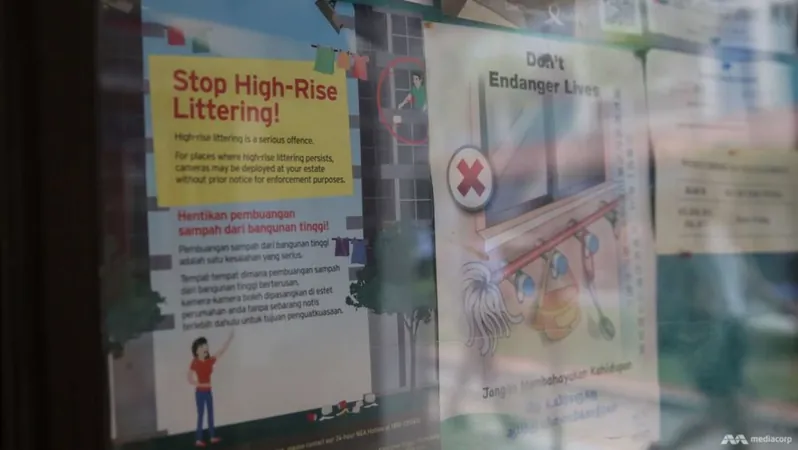
Singapore Embraces Innovative Tech to Battle High-Rise Littering: Are Drones the Future?
2025-01-08
Author: Siti
Introduction
In a bold move to combat the growing issue of high-rise littering, Singaporean authorities are currently assessing the potential of advanced technologies like drones and artificial intelligence for surveillance purposes. Senior Minister of State for Sustainability and the Environment, Dr. Amy Khor, revealed the initiative during a parliamentary session on January 8.
Exploring Technological Advancements
Dr. Khor emphasized the importance of staying abreast of technological advancements in video analytics and AI to enhance detection and enforcement capabilities related to littering offenses. “We are committed to exploring various methods to deter this anti-social behavior that poses risks to public safety and hygiene,” she stated.
Operational Measures by NEA
In an effort to tackle the problem more effectively, the National Environment Agency (NEA) is set to roll out new operational measures by the end of this year. Dr. Khor noted that high-resolution cameras will be deployed for longer periods and in more discreet locations to improve monitoring efforts.
Integration with Existing Measures
During the session, representatives from various constituencies probed Dr. Khor on how these tech-based solutions will integrate with existing enforcement measures. Although she acknowledged some challenges with drone usage—such as battery life, safety concerns in high-rises, and privacy issues—she reiterated that these technologies are meant to complement community engagement efforts rather than replace them.
Community Engagement
“Our ultimate goal is to foster a culture of responsibility and consideration among residents regarding littering,” Dr. Khor remarked. She pointed out that technology alone cannot resolve these behavioral issues; a multi-faceted approach that includes community involvement is crucial.
Positive Trends in Littering Feedback
Interestingly, there has been a noticeable decrease in littering complaints, with average feedback dropping from around 33,500 in 2020-2021 to approximately 27,100 in 2022-2023. The NEA actively collaborates with town councils by first issuing advisory notices to residents in areas where littering is reported. If issues persist, surveillance measures, including deploying cameras with video analytics, are enacted.
Camera Deployment Impact
From 2021 to 2023, cameras were placed in nearly all (97.1%) of the 7,400 persistent high-rise littering cases. However, some locations were deemed unsuitable for camera deployment due to structural design limitations. In cases where surveillance isn't feasible, the NEA plans to enhance educational outreach in affected communities and launch stakeouts based on eyewitness accounts.
Public Participation in Combating Littering
The public is encouraged to participate in combating littering by reporting neighbors engaged in such behaviors. They can submit video evidence to the NEA to aid investigations.
Challenges in Detection Rate
It's worth noting that the detection rate of littering incidents can fluctuate due to various factors, including weather conditions and the visibility of surveillance cameras. From 2021 to 2023, littering was identified in roughly 30% of surveillance camera deployments, leading to over 3,300 enforcement actions.
Conclusion
As Singapore continues to innovate in its fight against littering, the integration of cutting-edge technology with community-driven initiatives may just hold the key to transforming public behaviors and keeping its environment pristine. Will these measures create a litter-free Singapore, or are they just another tech gimmick? Only time will tell!


 Brasil (PT)
Brasil (PT)
 Canada (EN)
Canada (EN)
 Chile (ES)
Chile (ES)
 Česko (CS)
Česko (CS)
 대한민국 (KO)
대한민국 (KO)
 España (ES)
España (ES)
 France (FR)
France (FR)
 Hong Kong (EN)
Hong Kong (EN)
 Italia (IT)
Italia (IT)
 日本 (JA)
日本 (JA)
 Magyarország (HU)
Magyarország (HU)
 Norge (NO)
Norge (NO)
 Polska (PL)
Polska (PL)
 Schweiz (DE)
Schweiz (DE)
 Singapore (EN)
Singapore (EN)
 Sverige (SV)
Sverige (SV)
 Suomi (FI)
Suomi (FI)
 Türkiye (TR)
Türkiye (TR)
 الإمارات العربية المتحدة (AR)
الإمارات العربية المتحدة (AR)